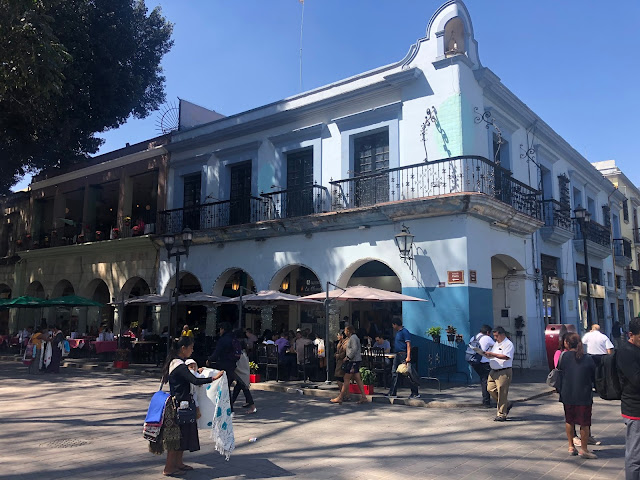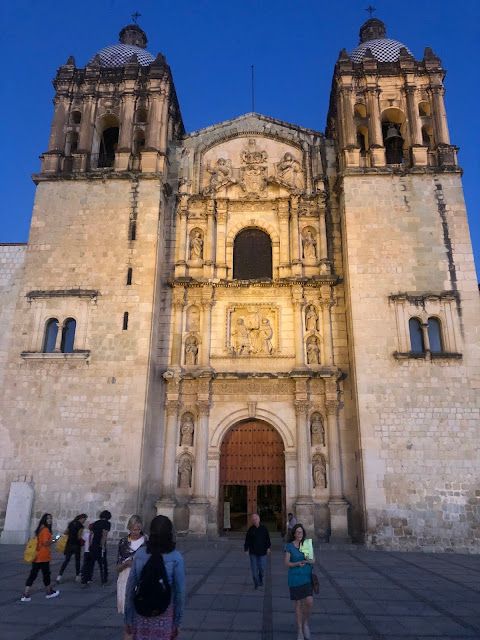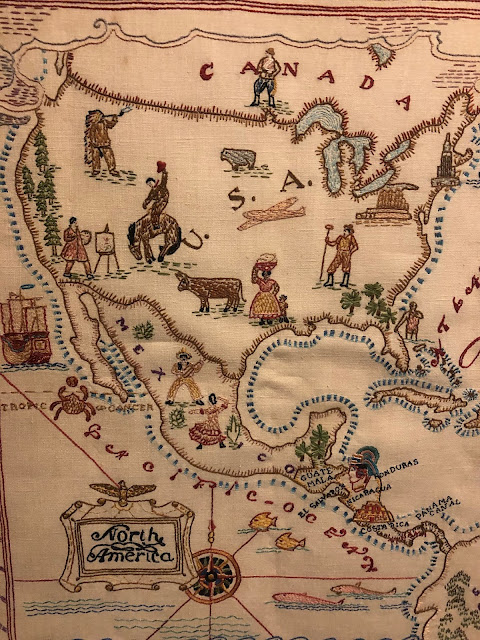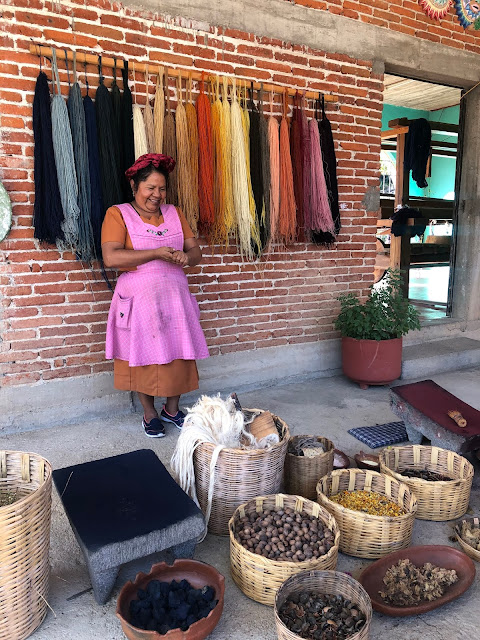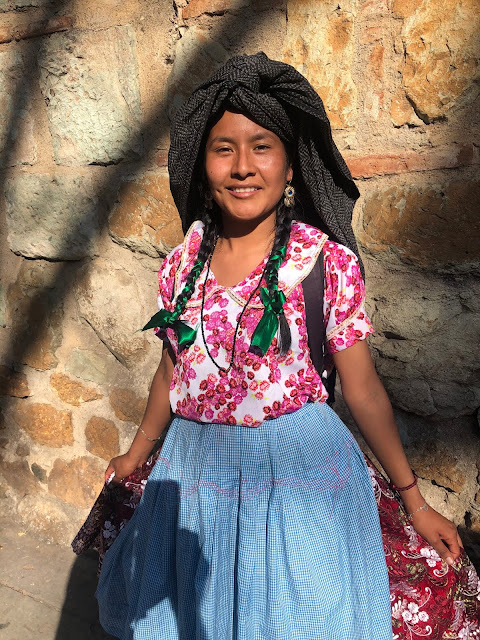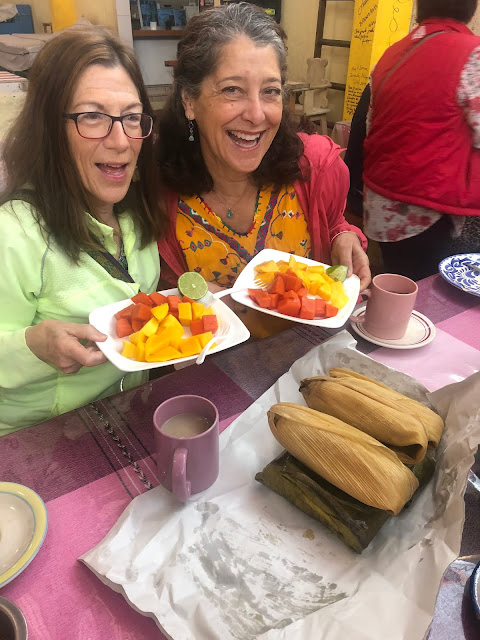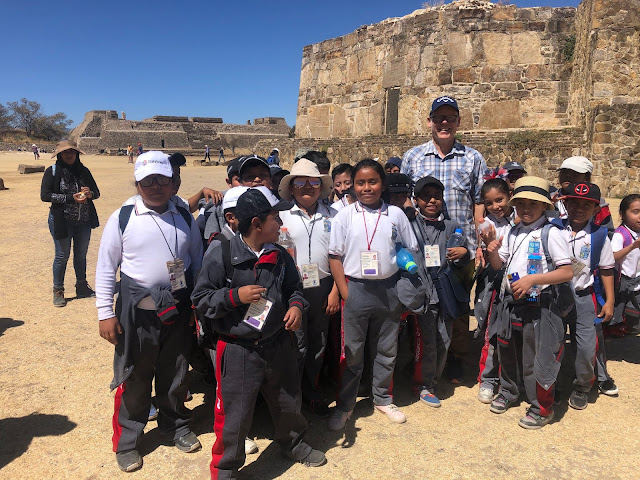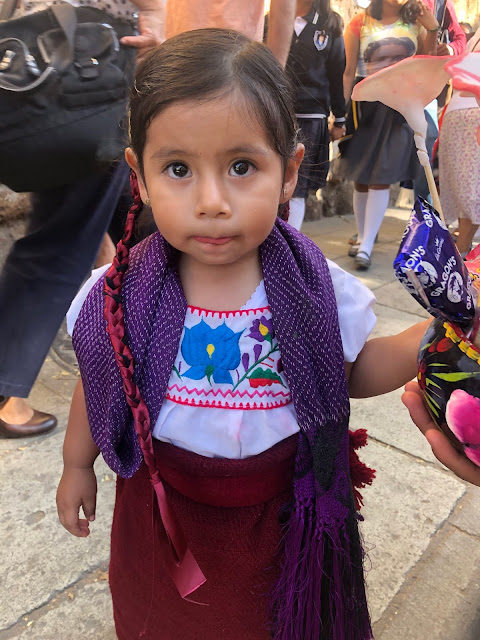5) Wonderful food - The cuisine of the state of Oaxaca is famous throughout Mexico and is getting international recognition. Perhaps most famous are the "moles" - rich sauces made from a huge mix of chiles, nuts, spices, chocolate and countless other ingredients. Also popular are "tlayudas" - large quesadilla-like Mexican pizzas built from a large, fried corn tortilla smothered with black beans and topped with lots of goodies. We loved the Oaxacan tamales, especially the black mole chicken tamales wrapped in banana leaves. And, lest we forget, there's mezcal - that smokey-flavored liquor distilled from the "pina" or heart of the maguey plant. Our wonderful tour guide - Tomas - seemed to know the best "mescaleros".
| Maria and Andrea enjoy their tamales for breakfast when they are at their freshest. | Maria's favorite were black mole chicken tamales wrapped in banana leaves. |
 | Scott sits down for a Oaxacan specialty - tlayuda. It's a large cooked corn tortilla
smothered with black beans, "quesilla" (Oaxacan string cheese), and a variety of toppings.
A Oaxacan pizza?
 | | A cooking class is a good way to appreciate the richness of Oaxacan cuisine. |
|
 | | The amount of ingredients in mole blew my mind. |
|
Hoffy making a chile relleno under the watchful eye of our excellent teacher Alejandra.
Mezcal versus tequila - If I haven't given you enough reason to love this wonderful area, here's another: Oaxaca is the capital for mezcal, a distilled spirit made from the agave plant. Unlike tequila, mezcal is made from a variety of agave plants and has a smokier, earthy flavor. We stopped at a number of roadside "mezcaleros" and learned how it is poduced. The hearts of the agave plants, called piñas, are cooked in pits in the ground similar to a barbecue. The cooked agave is then crushed, combined with water, and allowed to ferment. What a flavor!  | Here are the pines or hearts of the agave after having been cooked. Next steps is to crush them.
 | | A horse-drawn mezcal wheel to crush the pinas. Not high tech, but very tasty. |
 | Oaxacan chocolate, which comes from the cacao fruit that we are holding, is a
major speciality. |
|
6) Pre-hispanic ruins - The archaeological sites in the state of Oaxaca are so notable that they have been declared UNESCO World Heritage sites. The largest and most famous are Monte Alban and Mitla. Both were built by the Zapotec culture which flourished from 500 B.C. until the end of the Classic Period in 900 AD. As with many indigenous groups, contacts with the Spanish brought devastating influences of diseases and cultural domination.
 | | The Zapotec ceremonial center of Monte Alban lies only 15 minutes west of the city. |
 | We were also impressed with Mitla - a Zapotec administrative center active during
the arrival of the Spanish.
 | | I was impressed by the intricate stone facades of Mitla. |
|
7) Colorful Markets: Mexico is a land of markets ("tierra de mercados") and nowhere is this more prevalent than in Oaxaca. The town itself has amazing covered markets - Mercado de Benito Juarez, Mercado de 20 de Noviembre, Mercado de Bastos - replete with food, crafts, clothing, housewares and everything else imaginable. The surrounding villages are more famous for outdoor, indigenous markets with arts, crafts, clothing and food galore.
 | Mexican urban markets are a labyrinth of color and merchandise. I've often wondered where
they produce this tremendous quantity of stuff. I guess it goes back to Adam Smith's "invisible
hand" from The Wealth of Nations in 1776! |
 | | We bought fresh chiles for our cooking class. |
 | | The food in the 20th of November Market was beautifully displayed. |
 | | Oaxaca state is famous for its village, outdoor, indigenous markets. |
| |
 | | Mother and daughter sell nuts, coffee and cacao beans for chocolate. |
8. Wonderful, friendly people - We absolutely loved our Oaxacan adventure. This delightful city and its surrounding region are the best that Mexico has to offer. I loved San Miguel de Allende but I find that Oaxaca is more authentically Mexican. Mexico City has incredible sites, but I felt overwhelmed at times by the big crowds. I will certainly organize a Hoffy Tour to this jewel of a town.
Once again, however, what I love most about Mexico is its friendly and gracious people. Here I am with a class of Mexican students on a field trip. This is my idea of heaven on earth!
|


